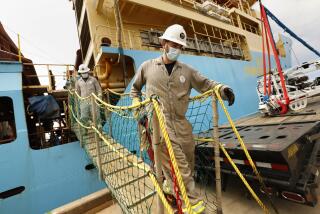Environmental Battle Looms Over Coal Plan : Facility May Harm Bay but Help Weak Industry
- Share via
A plan to operate an unusual coal-handling facility in the middle of the Delaware Bay has become the subject of a fierce legal battle pitting Delaware officials and environmental groups against Norfolk Southern Corp., the Virginia congressional delegation and the U.S. Justice Department.
Delaware officials and environmentalists contend that the Norfolk Southern facility would dump millions of tons of coal into the bay, damaging the state’s seashore and gutting in the process one of the nation’s strongest coastal-protection statutes. Joining Norfolk Southern in defending the plan are a variety of government officials who fear that, without the project or ones like it, slumping American coal exports never again will be able to compete effectively on the world market.
Norfolk Southern lawyers produce a number of studies purporting to show that the project is environmentally benign. At the same time, industry experts suspect that the time is fast passing when the planned facility would provide significant economic benefits to the nation’s coal industry.
May Decide Soon
A federal judge in Wilmington, Del., is wrestling with these complicated issues, and lawyers say he is expected to hand down a decision soon on a suit brought by Norfolk Southern alleging that the Delaware law prohibiting the facility is unconstitutional. Oral arguments from both sides were heard last month, and U.S. District Judge Murray Schwartz could rule on the case himself or he could decide that a jury trial is necessary.
If upheld on appeal, Schwartz’s decision would put an end to a controversy that has dragged on for more than two years and that, in a way, has been brewing since the 1971 passage of the Delaware Coastal Zone Act, the first of 28 state coastal-protection programs adopted around the country.
The act barred manufacturing facilities--such as oil refineries or steel mills--from locating within two miles of Delaware’s 115-mile coast line. The statute also prohibited construction in the bay of facilities for loading liquid and solid bulk materials, although oil-transfer operations already there were permitted to remain.
The second prohibition was significant because the Delaware Bay, while on the one hand an oft-used area for fishing, swimming and watching wildlife, is also the only area south of Maine on the Atlantic Coast with waters deep enough to accommodate the supertankers that have come to dominate world shipping.
Channels Too Shallow
Many of the long-prominent East Coast harbors, such as Baltimore or Norfolk, have channels that are less than 50 feet deep--and hence are unable to accommodate fully loaded supercolliers, as the 100,000- to 150,000-ton cargo vessels are known. Efforts to dredge these harbors so that they can receive these ships have been held up by political wrangling and the difficulty of obtaining federal funding.
Given the growing cost effectiveness of shipping in larger vessels, coal and shipping executives began searching in the late 1970s for alternatives for handling the big ships. Their solution: “topping off” the supercolliers at the Big Stone Anchorage in Delaware Bay.
In a top-off operation, supercolliers are partly loaded with coal and then sent out to sea, where they reconnoiter with a barge also filled with coal. Cranes operating from the barge then “top off” the tanker, filling its cargo hull with the additional coal. The procedure now is performed only on a scatter-shot basis along U.S. coasts.
After a number of aborted efforts since the late 1970s to develop the necessary facilities in Delaware Bay, a new proposal was advanced in the summer of 1983. Norfolk Southern Corp., the transportation giant, announced that it would provide a coal top-off service in Big Stone Anchorage’s 55-foot waters for ships loading at its Lamberts Point coal piers in Norfolk. The project would be carried out with the Coastal Barge Corp., a U.S. shipping concern that had conceived it. The total cost of the barges and tugs involved in the plan was projected at about $36 million.
Cuts Shipping Costs
The impetus for the project was clear: the desire to shave shipping costs by enabling the cost-effective supercolliers to pick up coal on the East Coast. It didn’t hurt that the U.S. Maritime Administration agreed to guarantee a loan Norfolk Southern took out to purchase a 35,000-ton barge for the project.
In 1982, 37 million tons of coal and coke--coal from which most of the gases have been removed by heating--were loaded at Norfolk Southern’s docks for shipment abroad and to other U.S. ports, and that total was expected to increase as a result of the increased capabilities that would be afforded by the top-off procedures. The company predicted that the move would enable U.S. coal to become more competitive with other major coal-exporting countries, including Australia, Poland and South Africa. More concretely, officials projected that if the plans were realized, revenue from the top-off facility would amount to $10 million a year by 1986, according to court documents.
None of the plans materialized, however. In fact, the whole project came to a screeching halt in the courts.
Before its announcement, Norfolk Southern had little reason to believe there would be any governmental objection to its proposed top-off service. Until 1983, the anchorage was reserved solely for oil transfers, but in May of that year the Coast Guard, which has jurisdiction over the area, ruled that other commodities could be transferred there, including coal. Norfolk Southern officials also have testified in court that they kept Delaware officials informed of their plans, and that these officials assured the company that its plans fell within the bounds of the state’s Coastal Zone Act.
Questions Surfaced
As soon as the company’s plans became public, however, questions surfaced as to the operation’s legality. Ultimately, state environmental officials ruled that the the top-off project constituted a “bulk-product transfer facility” of the type prohibited by Delaware’s environmental statute, and the decision was upheld by the state Supreme Court.
In the meantime, Norfolk Southern pondered other options. In June, 1984, almost a year after it first announced its plans, the company filed suit in federal court in Delaware, asking that part of Delaware’s Coastal Zone Act be declared unconstitutional because it interferes with interstate and foreign commerce. This is the action now pending in Schwartz’s court.
Although the case has come to be viewed by environmental groups as having significance beyond Delaware, Norfolk Southern lawyers and officials say they are interested only in overturning a narrow part of the state’s coastal zoning statute that they say can’t pass constitutional muster.
More to Read
Sign up for Essential California
The most important California stories and recommendations in your inbox every morning.
You may occasionally receive promotional content from the Los Angeles Times.










